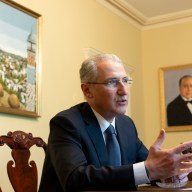EDMONTON – The Alberta government says it believes arson was behind a wildfire that ravaged the town of Slave Lake last spring.
Sustainable
Resource Development Minister Frank Oberle says the province’s
investigation files have been turned over to the RCMP.
(In Pictures: Wildfire ravages Slave Lake, Alberta)
Oberle says the force will determine whether a criminal investigation is needed.
The provincial investigation took more than five months.
“Our
investigation took the time required to protect, collect, analyze and
document evidence to the rigorous standards required for preparation in a
court of law,” Oberle said.
Deputy Commissioner Dale McGowan,
commanding officer of the Alberta RCMP, said investigators with the
serious crimes branch in Edmonton are conducting the review and will
have control of any subsequent investigation.
He could not say how long that will take.
“The
RCMP has a very keen understanding of the devastation caused by this
fire,” said McGowan. “I want to reassure the citizens of Alberta that a
thorough review of the (Sustainable Resources) report is a matter of
high priority for the RCMP.”
Slave Lake is still struggling to
get back on its feet after the mid-May forest fire that was whipped by
100-km/h winds and engulfed one-third of the community. It torched 400
homes and businesses and left 2,000 people homeless.
Total damage
was pegged at $700 million, which insurance adjusters estimate makes it
the second-costliest disaster next to the Quebec-Ontario ice storm of
1998, which cost about $1.8 billion.
The fire forced all 7,000
residents of the town, 250 kilometres northwest of Edmonton, to leave
for two weeks as fire crews completed their salvage work and police
secured the area.
No one was hurt, but a fire-fighting helicopter
pilot crashed on Lesser Slave Lake and died. There were 1,400
firefighters deployed along with 170 helicopters and tankers.
Images
of entire neighbourhoods razed to ash, homes reduced to charred cement
foundations, were beamed around the world. In July, Prince William and
his wife Kate made an impromptu visit during their cross-Canada tour to
show support.
The aftermath raised questions over how the
evacuation was carried out. Residents wanted to know why they were not
given ample warning to leave. Some who left on their own were forced to
turn around when roads were closed.
Days after the fire, the
Alberta Emergency Management Agency, said it did not recommend an
evacuation, then later reversed its position and said it had directed
Mayor Karina Pillay-Kinnee to do so.
Pillay-Kinnee said the
province ordered the evacuation after 6 p.m. on that fateful Sunday, but
by then heavy smoke had closed the access roads out of town.
Municipalities are responsible for ordering evacuations but are dependent on information and fire updates from the province.
Communities
around Slave Lake had been evacuated a day earlier, but town residents
were told online and by radio that they were safe – even as fire began
destroying the town.
The province delivered almost $300 million
in aid, including millions for modular homes for residents who lost
everything. Money was also delivered to surrounding communities that set
up evacuation centres.
In August, the province announced an
independent review of how well it fought the fire and on the overall
effectiveness of its fire management programs. It is led by Bill
Sweeney, a one-time RCMP senior deputy commissioner.














